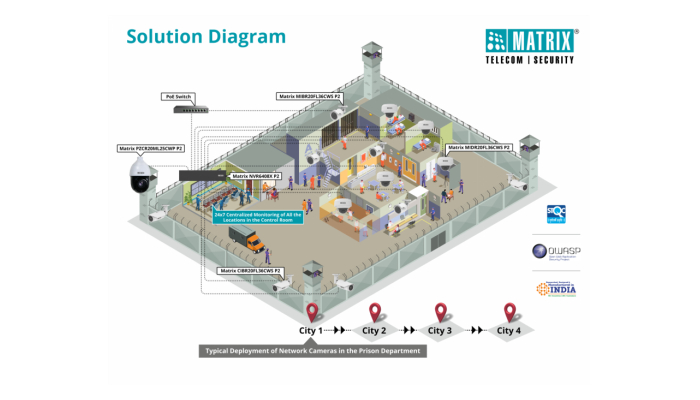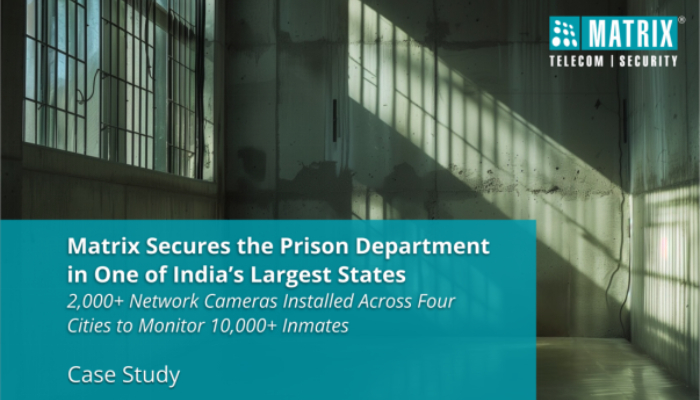Scenario:
The absence of a security video surveillance system created critical security blind spots, making it difficult to monitor key areas effectively. The need for a robust solution became clear after issues like hidden illegal items and unmonitored inmate movements posed significant risks to prison security.
To comply with government regulations, the new security video surveillance system had to adhere to stringent standards established by the Bureau of Indian Standards (BIS). This included specific sections detailing the specifications for camera performance and image quality and covering safety guidelines for IT equipment. The system required STQC certification to meet high security and data privacy standards, crucial for government installations. Additionally, it needed to comply with OWASP ASVS 4.0 L2 standards to ensure robust cybersecurity, safeguarding against common vulnerabilities. High-resolution cameras were essential for clear image capture, and tamper-proof storage was required to securely retain footage for 30 to 90 days. The system also had to align with the National Cyber Security Policy to protect sensitive data from cyber threats. Compliance with these standards was vital for maintaining security and operational integrity within the prison.
Challenges:
Due to the absence of a security video surveillance system, the Prison Department faced numerous challenges such as:
- Struggled to monitor blind spots in the prison yard where fights and disputes frequently occurred.
- Detecting the smuggling of drugs and mobile phones during visitations was nearly impossible with manual checks alone.
- Staff couldn’t always be present to monitor isolated areas like back rooms, corridors, and staircases, leading to security gaps.
- Identifying the individuals involved in riots or brawls was difficult due to the lack of visual evidence.
- Inmate escape attempts often went unnoticed until too late, especially during night shifts.
- Ensuring round-the-clock monitoring of high-risk zones like solitary confinement was a constant challenge.
- Coordinating emergency responses, such as medical help during violent outbreaks, was delayed without instant visual updates.
Solution:
Matrix security video surveillance system comprising of Matrix Network Cameras and NVRs were installed across four prisons statewide, providing robust security for over 10,000 inmates.
Matrix PTZ Cameras were deployed in larger spaces like the prison yard, where they could pan, tilt, and zoom to follow suspicious activities or fights, providing dynamic coverage and ensuring swift responses to incidents.
Mini Dome Cameras were placed inside cells and common areas to provide constant, wide-angle surveillance, keeping tabs on inmate behavior and reducing the chances of fights or smuggling illegal items. These cameras were also installed in cafeterias and recreation areas to monitor inmate interactions.
Mini Bullet Cameras were installed in corridors and cellblock hallways to keep a close eye on inmate movement, ensuring no blind spots in these high-traffic zones. They were also installed in less-visited areas like storage rooms and staff offices to prevent unauthorized access and maintain control.
Project Bullet Cameras were mounted along the prison yard and perimeter walls, providing long-range surveillance to prevent escape attempts and monitor outdoor activity. They were also installed at entry and exit points to keep tabs on everyone going in and out, securing access to the facility.
All Matrix Network Cameras were centrally monitored with Matrix 64 Channel NVRs. This setup enabled 24×7 real-time monitoring, recording, and playback of video from different areas of the prison, ensuring complete coverage and prompt incident response.
Similarly, the prison departments in three other cities of the state were also secured with Matrix Network Cameras and NVRs.

Benefits:
The installation of Matrix security video surveillance system effectively eliminated critical security blind spots in the prison yard, reducing the risk of fights and disturbances. They ensured round-the-clock surveillance of high-risk zones, such as solitary confinement and cell blocks, preventing inmate escapes and unauthorized movements.
Matrix security video surveillance systems enabled accurate monitoring during visitations, significantly enhancing the detection of smuggling attempts for drugs and mobile phones.
Centralized monitoring via the 64-Channel NVR allowed for quick identification and response to disturbances, ensuring timely intervention during riots or medical emergencies.
High-resolution camera footage provided reliable documentation of inmate interactions and incidents, supporting investigations and enhancing overall prison security management.
Matrix security video surveillance system meets BIS and STQC standards, ensuring compliance with government regulations for safety and data privacy. It also complies with OWASP ASVS 4.0 L2 standards, enhancing data security and protecting against cyber threats.
Company Profile:
The office of the Additional Director General of Police (ADG) and Inspector General (IG) of Prisons oversees the management and security of all prisons in the Indian state. This includes ensuring the safety of prison facilities, implementing rehabilitation programs for inmates, and managing prison staff. The ADG and IG focus on improving prison conditions and ensuring legal standards are met. Their goal is to create a secure and fair environment, balancing safety with efforts to reform and rehabilitate prisoners for their eventual return to society.



